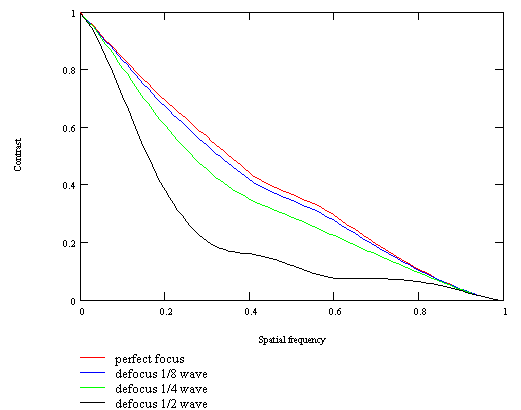
THE FOCUSING
The focusing is one of the most difficult tasks in CCD imaging. It is useless to have an instrument with perfect optics if the focusing is defective, the power of the instrument is lost since a defocusing can be considered as an aberration (like spherical aberration) which causes a distorded wavefront.
The focusing tolerance required at the focus of an instrument depends on its resulting focal ratio (R), on the wavelenght (l) and on the maximum wavelenght fraction of the distorded wavefront (Dl):
T = ▒ 8 . R2 . l . Dl
Example : at 0.6 Ám, at the F/D 6 focus of an instrument, the focusing tolerance which leads to a focusing precision better than l/8 is 8*62*0.0006*(1/8) = 0.02 mm, ie ▒ 20 microns.
The focusing tolerance is proportional to the square of the focal ratio. A F/D 5 instrument has therefore a tolerance four times smaller than a F/D 10 instrument. This is the reason why Schmidt telescopes, which are very fast systems (F/D 1 to F/D 2), are extremely demanding about focusing.
The figure below (see What is a FTM curve ?) describes the loss of contrast caused by defocusing of respectively l/8, l/4 et l/2 on the wave (obstruction 20 %).

In high resolution, the focuser and the method used for focusing must allow a positioning better than l/8.
|
F/D |
2 |
3 |
4 |
5 |
6 |
8 |
10 |
12 |
15 |
20 |
30 |
|
Tolerance |
0.0025 |
0.005 |
0.01 |
0.015 |
0.02 |
0.04 |
0.06 |
0.09 |
0.13 |
0.24 |
0.54 |
The table above gives the focusing tolerance (in microns) for several F/D ratios, for a tolerance of l/8. When the reliability of a focuser is examined, the focal ratio that must be taken into account is the focal ratio at the level of the mobile element used for focusing: primary mirror in a Schmidt-Cassegrain, focuser in a Newtonian or a refractor. The focal ratio of the primary mirror in a SCT is generally close to 2: the focusing tolerance required at l/8 for this mirror is ▒ 2.5 microns only ! The simulation below shows the effect on a planetary image of a shifting of such a primary mirror of 1/100 mm (1/2500").
|
|
|
In visual observation, the eye can compensate for small focusing defects (accommodation). In photography or in CCD, it is not possible, and therefore:
- the focusing system must be very reliable and without any play,
- any focusing help is welcome: dial gauge, focuser with graduations, flip-mirror with calibrated eyepiece, etc.
- focusing must be periodically checked during imaging sessions, because thermal expansion of mechanical and optical elements change the position of the focus.